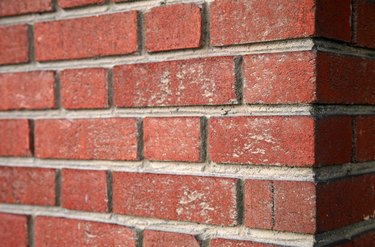
The most likely reason for drilling into brick or mortar is to hang something, but it's also possible that you want to attach something to the wall, such as a wooden brace to support a cabinet or another structure. In either case, you'll find the going easier if you drill into the mortar because it's softer than brick, but by the same token, mortar can't support as much weight. In most cases, you'll want to drill into the brick.
An exception to this guideline is when the brick itself is old and flaky. In that case, the brick is likely to crumble, and even if you successfully drill the hole, whatever fastener you use has a better chance of pulling out than it has from the mortar. When drilling into mortar, you need the right drill bit and the right drill.
Video of the Day
Video of the Day
Limitations of Drilling Into Mortar
Just like concrete, mortar is a mixture of Portland cement and a filler, but whereas the filler in concrete is usually stone aggregate, the filler in mortar is sand. If you think of mortar as sand held together by an adhesive, you'll understand why it doesn't have as much holding power as brick, which is clay fired at high temperatures. The maximum weight you can expect mortar to hold without crumbling is about 4 pounds.
The size of mortar joints also limits the size of the holes you can drill in them. It's important for the diameter of a hole not to exceed the width of a mortar joint because that weakens the joint and could cause it to crumble. The standard width of mortar joints is about 3/8 inch, so that's the maximum size of the hole you should plan on drilling.
Use the Right Drill and Drill Bit
When drilling into brick, the standard procedure is to do the job with a hammer drill, but when drilling into mortar, you should just use a conventional drill. The hammering action may make the job easier, but it's likely to cause the mortar to crumble. The job may take a little longer if you use a standard cordless or corded drill, but mortar is soft, so it won't take that much longer, and it's safer.
Never try to drill into brick or mortar with a wood-boring bit; you'll ruin the bit before the hole is even completed. It's best to use a carbide-tipped masonry bit for brick, and that's also the best bit to use for mortar. A masonry bit with a steel tip will also work. Just make sure the bit is the proper diameter for the anchor or fastener you're going to use.
How to Drill Into Mortar
When drilling into brick, pros often first drill a smaller pilot hole, but because mortar is softer, you usually don't need to do this. To prevent the tip from wandering as you start the hole, it often helps to lay masking tape over the mortar and drill through that. Once the hole is about 1/8 inch deep, remove the tape to prevent mortar dust from accumulating behind it.
Use a variable-speed drill and operate it at a slow speed to prevent the bit from overheating. Even if you do this, however, the bit will get very hot, so to prevent it from warping or breaking, you should extract it from the hole every so often and dip it in a bowl of water to cool it down. Because mortar is so soft, it shouldn't take more than a minute or two to drill a hole to whatever depth you require.